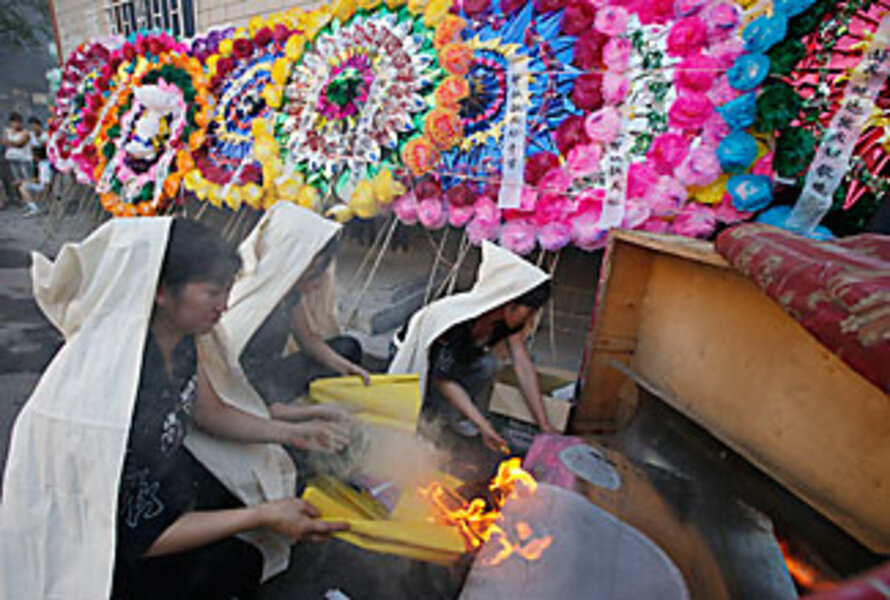China raises casualty toll in Uighur riots
Loading...
• A daily summary of global reports on security issues.
Senior Chinese officials are working double time to restore order to the restive far-western province of Xinjiang after rioting there last week killed more than 150. The disputed death toll is now 184, and the number of injured is higher, too. A top Chinese official visited the region for the first time this weekend, accusing a dangerous fringe of organizing the unrest and calling on people of all ethnicities to build "a steel wall" against instability.
But activists and observers contest the idea that the unrest was the work of extremists. Instead, many say it is a wake-up call that the region is riddled with economic and ethnic tensions. Until those are addressed, it is unlikely Xinjiang's people will come together to build anything, let alone a metaphorical second Great Wall.
The New York Times reports that the riots began last Sunday in Urumqi, Xinjiang's capital, when a protest by Muslim Uighurs ended in clashes with riot police. They are a majority in the province but a minority nation-wide, and complain of discrimination at the hands of China's main ethnic group, the Han. The Times piece talks to scholars who note that Chinese rulers first began to exert full control of the area in the mid-1700s. And under Mao Zedong, the Han population grew from 6 to 40 percent.
For days after the police clashes, Uighur vigilantes attacked and killed Han civilians, who responded with their own attacks on Uighurs. China's state-run Xinhua news agency reported Sunday that the official number of injured had risen from 1,100 to 1,680,and that 184 people were killed – mostly Han.
But Uighur residents of Urumqi say the official death toll under-reports the Uigher casualties, according to the Washington Post. The actual number of Uighers killed could be in the thousands, they say.
On Saturday, senior Communist Party official Zhou Yongkang told reporters that the people of Xinjiang should come together to build "a 'steel wall'" for the region's stability to safeguard the interests of the people," according to Xinhua.
Mr. Zhou is the first top party leader to visit the province since the July 5 riots began. He used the visit to accuse unnamed hostile foreign elements of master-minding the unrest, says Xinhua, and warned that "they are attempting to stage more sabotage."
State-run China Daily towed a similar line, says Xinhua, writing in a Friday editorial: "To maintain social stability, we need to isolate and crack down hard on a handful of people ... who masterminded, organized, and committed serious violence during the riot."
But most analysts disagree with the argument that the riots were organized by extremist elements or foreign saboteurs. Instead, many connect the unrest to poverty and long-standing Uighur complaints of discrimination in their own homeland, which has seen a huge influx of Han migrants since the 1980s, reports Agence France Presse.
Xinjiang is rich in natural resources, notes AFP. The province is now China's second-largest oil producer, and agriculture is a big business, too. Beijing invests heavily in both. But analysts say Uighurs see few of the benefits of that investment, which favors Han Chinese.
Around 70 percent of any extra investment is gobbled up by the oil and petrochemical industries, dominated by state-owned enterprises, said Ren [Xianfang, an analyst at IHS Global Insight.]
"There are very few Uighurs in the oil industry," said Jean-François Huchet, director of the Centre of French Studies on Contemporary China in Hong Kong.
"The Uighur population has been stuck in the countryside in an agricultural system that has little added value," he said.
But even there – the region is a major grower of cotton – Uighurs struggle to gain economic power.
A regional quasi-military group, "the bingtuan," control huge tracts of farmland, employing more than 2.2 million people there, the vast majority of whom are Han Chinese.
But some Uighur leaders go farther, saying that the only foreign element interfering in Xinjiang is China itself.
Speaking to the Times of India, US-based Uighur leader Rebiya Kadeer said the riots were part of a broader movement for "freedom."
"All colonised people resent unjust foreign rule that is forcibly imposed upon them. It's always a matter of time before the colonised rise against their colonisers. How long are we going to live in our own country as second-class citizens and slaves? We want freedom. That is all we want."





